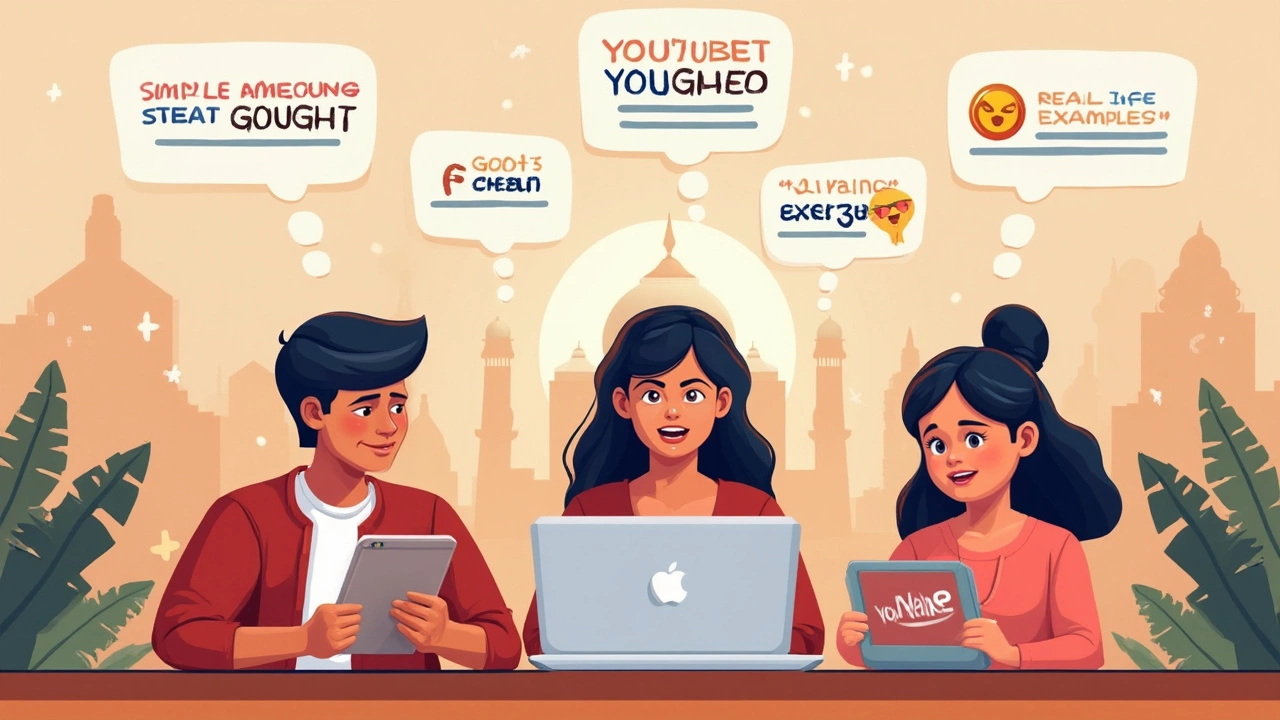Best YouTube Channel for Spoken English: A Practical Guide
 Jun, 8 2025
Jun, 8 2025
Scrolling through YouTube for English lessons can feel like searching for a needle in a haystack. One moment, you’re watching a guy teach grammar with kitchen utensils—next, someone’s acting out airport scenes with sock puppets. So many channels promise 'fluency fast,' but real progress happens when you know what you’re looking for.
The best YouTube channels don’t just throw vocabulary lists at you. They actually walk you through conversations you’d face if you got lost in London—or needed to ask for WiFi at a café. And let’s be honest, it’s way easier to learn from someone who breaks things down with simple rules and lots of relatable examples, not endless textbook jargon.
If you’re overwhelmed by choices, don’t worry—you’re not the only one. My dog Luna’s English is stuck at 'sit' and 'walk,' but readers like you have way more potential. Let’s sort through what actually matters so you don’t waste time on lessons that leave you more confused than before.
- Why YouTube Works for Spoken English
- Top Channels Worth Your Time
- What Makes a Channel Truly Helpful
- Tips for Getting the Most Out of Free Lessons
Why YouTube Works for Spoken English
YouTube nails spoken English for one simple reason—it's real. You’re not stuck with boring classroom scripts or stiff dialogue. Instead, you get lessons that use how people actually speak today, from street talk to business meetings. A 2023 report from the British Council said, “Learners using authentic video resources make faster progress in natural spoken communication.” So, watching YouTube isn’t just fun, it’s proven to be effective.
You’ll find channels that focus on accent, listening skills, or even just surviving small talk at a party. What makes these videos stand out is that many of the teachers are native speakers, so you get the kind of pronunciation and expressions you’d hear on the street—not what you find in old textbooks.
Here’s what makes YouTube work better than most free options:
- Videos fit any schedule; watch on your commute or before bed.
- Pick topics you care about—want to learn business English? There’s a playlist. Trying to nail movie slang? There’s a channel just for that.
- Free subtitles and playback speed controls help you catch every word (rewind as much as you need!).
And let’s face it, motivation matters. YouTube teachers usually have infectious energy. You’re way more likely to finish a 10-minute video where someone’s breaking down the latest meme than reading another dull grammar lesson. Plus, you can interact in the comments to ask questions or find practice buddies.
According to research published by Edutopia, “Learning through multimedia boosts memory and understanding much more than textbook methods alone.” So next time you’re debating between watching an old sitcom or a spoken English lesson on YouTube, remember: With the right channel, you might do both at once—and actually learn something useful.
YouTube bridges the gap between textbook learning and real-world conversation, making spoken English more accessible to everyone. —British Council, 2023
Top Channels Worth Your Time
There’s no shortage of YouTube channels claiming to boost your English, but only a handful actually help you speak and understand like a regular person. I’ve spent hours watching, rewinding, and groaning at the awkward acting on some, so you don’t have to. Here are the ones that stand out and why.
- English with Lucy – Lucy Earl’s channel is a crowd favorite, sitting at over 13 million subscribers in mid-2025. Her teaching style mixes British charm with clear examples and real-life phrases. She explains pronunciation and common expressions, and her videos about confidence in small talk are great if you freeze up in real conversations.
- Learn English with TV Series – If you’re tired of boring lessons, this channel teaches spoken English by breaking down dialogue from popular shows and movies. You get to hear how people actually talk—not just how they’re “supposed” to talk. Their explanations of fast native speech and slang are a game-changer for understanding modern conversations.
- Rachel’s English – If American pronunciation is your goal, Rachel packs her channel with step-by-step pronunciation lessons, mouth movements, and even live practice sessions. The channel’s focus on intonation and stress is super practical for sounding natural and not robotic.
- EnglishAddict with Mr. Duncan – Mr. Duncan’s been on YouTube since 2006, and his lessons are anything but stiff. He uses humor, simple stories, and live Q&A sessions, making it easy to join in and practice, not just watch passively.
Here’s a quick comparison so you can pick what fits your needs. Views, subscribers, and start years are from this summer:
| Channel | Subscribers | Focus | Notable Strengths |
|---|---|---|---|
| English with Lucy | 13M+ | British English, everyday speaking | Pronunciation, small talk, clear basics |
| Learn English with TV Series | 9M+ | Native TV/movie dialogue | Modern slang, real conversations, pop culture |
| Rachel’s English | 4.5M+ | American pronunciation | Accent, intonation, practice exercises |
| EnglishAddict with Mr. Duncan | 950K+ | Everyday English, live talk | Humor, live interaction, beginner-friendly |
Don’t chase subscriber counts alone. Think about what accent you want, if you like structured lessons or TV references, and pick the one that keeps you coming back. That’s way more important than just hitting play on the first video you see.

What Makes a Channel Truly Helpful
Not all YouTube channels are created equal when it comes to spoken English. The ones that really help you improve aren’t just about flashy thumbnails or funny skits—they’re about practical, clear teaching. Here’s what sets the good ones apart.
First off, a helpful channel keeps things simple. If you can’t follow what they’re saying or you feel lost five minutes in, it’s not worth your time. The top channels break lessons into bite-sized concepts, use everyday examples, and repeat key ideas (but not so much you want to skip the video).
- Spoken English channels need real-life conversations, not just scripted lines. You want hosts who use stories, answer common questions, and explain why people say things a certain way.
- Good channels let you hear different accents—from British to American to Aussie, especially if you plan to travel or work internationally.
- They show native-level phrases and also explain casual responses, like how to really say “How are you?” (Hint: it’s not always “I am fine, thank you.”)
- Bonus points if the channel offers quizzes, challenges, or exercises so you’re not just a passive watcher. You need to try saying things out loud—otherwise, it’s just background noise.
Check out the table below. It sums up what to look for if you want a channel that actually levels up your spoken English.
| Channel Feature | Why It Matters |
|---|---|
| Real-Life Dialogue | Prepares you for actual conversations |
| Accent Diversity | Helps you understand more speakers worldwide |
| Clear Explanations | Makes grammar and phrases stick |
| Practice Prompts | Involves you, not just entertains |
| Active Community | Lets you ask questions and get feedback |
Lastly, stay clear of the channels promising “speak like a native in one week.” Those always sound tempting, but language just doesn’t work like that. Stick with creators who keep it honest, practical, and down-to-earth—you’ll make way more progress.
Tips for Getting the Most Out of Free Lessons
Free lessons on YouTube can take your spoken English to a whole new level—if you make the most of them. Just watching and nodding isn’t going to cut it. You need a game plan. Here’s what works if you want clear progress and not just another video in your history tab.
- Pick a Consistent Time: Set aside a daily slot, even if it’s just 20 minutes. Consistency trains your brain to expect and retain new words and phrases.
- Repeat Aloud: Hearing is good, but speaking is better. Pause the video after every new phrase and repeat it. Don’t worry if you sound funny at first—your dog wouldn’t care, and neither should you.
- Take Simple Notes: Jot down words and everyday phrases, then try to use them during your day. Carry that notepad when you go for a walk or run errands.
- Engage with Comments: Some of the best channels have active communities. Ask questions, answer others, or just say ‘thanks for the tip.’ This little social step helps keep you motivated.
- Self-Check Your Progress: Test yourself weekly. Can you introduce yourself without looking at notes now? Can you order take-out in English without feeling nervous?
Here’s what learners usually experience if they follow these tips compared to just binge-watching random videos:
| Regular Practice | Just Watching Videos |
|---|---|
| Vocabulary grows by 30-50 words a week | Only remember 5-10 words weekly |
| More comfortable speaking after one month | Still shy about speaking after months |
| Can understand common accents faster | Struggle with listening comprehension |
One last trick: pretend you’re teaching Luna (or your pet, or even a plant). Explaining things out loud is proven to boost understanding. Don’t just observe. Get your mouth moving—real progress depends on it.